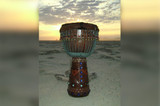Putting a Little Jingle in Your Jangle
Drumming is often an act of love. It calls for a lot of sweat, maybe some tears, and certainly a bit of enthusiasm. A dedicated drummer may spend hours lost in the creative space others may refer to as ‘oblivion’. The passion and intensity drummers put into their craft often results in explosive, hypnotic acts that call out to everyone within range of hearing.
Percussion accents have likely been used by drummers since ancient times. These accents not only give more dimension to the music, they also allow for more creativity. Instruments like tambourines and bells accompany many traditional drumming sessions in certain parts of the world. While in the past, the accents may have been more likely to be used by the dancers accompanying the drummers or by the rapt participating audience; these days, drummers themselves are adding accent percussion to their drums using various methods.
Tambourines and cowbells, for example, are available for purchase with their own stands so that the drummer can use them as part of a creative drum kit. While accents may be used with a regular drum kit, they can also be used with congas, djembes, or any other kind of drum. The point is to arrange the instruments so that they are easily reached and can be incorporated into the music without disturbing the flow.
For this reason, employing these new sounds may require a change in routine for a drummer just getting started. Perhaps the drummer who is used to standing while playing may now need to sit or vice versa. This flexibility will pay off, because the accents allow for diversity in sound and can trigger creativity in a drummer. A new sound to play with is like heaven for a percussionist, so don’t be surprised if a bit of tinkering results in a new composition.
There are a variety of instruments that can be used as percussion accents. Tambourines and bells might seem like the most widely used (outside of cymbals), but many world drummers also use claves and blocks. Playing a couple of the instruments together can really add depth to a piece. It is also traditional in some parts of the world for drummers to wear bracelets of bells or rings, so that they provide the tones themselves as they pound rhythms from their drum hides. No matter whether the jingles, jangles, bells or blocks placed on a stand, hooked onto the drum’s frame, or worn by the drummer, they are sure to please both drummer and listener alike.
Recent Posts
-
What is the Best Size Djembe for Beginners?
If you're new to the world of percussion and interested in learning the djembe, you're in for a t …16th Jul 2024 -
The Benefits of Becoming a Drumming Teacher: Transforming Passion into Profession
Why become a drumming teacher? Becoming a drumming teacher is an excellent way to share your pas …22nd May 2024 -
What Makes the Djembe Drum a Spiritual Instrument in African Music?
Origin and history of the Djembe drum The Djembe drum originates from West Africa and holds sign …16th May 2024



